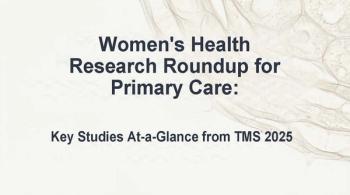
Drug Benefit Trends
- Drug Benefit Trends Vol 20 No 2
- Volume 20
- Issue 2
Medicare Prescription Drug Coverage
A proposal by the Centers for Medicare & Medicaid Services (CMS) published in the January 8 issue of the Federal Register would allow stand-alone Part D plans to offer reduced premiums to enrollees with limited incomes and resources-a rule intended to give such enrollees in each Medicare prescription drug benefit region at least 5 options with no monthly premium.
A proposal by the Centers for Medicare & Medicaid Services (CMS) published in the January 8 issue of the Federal Register would allow stand-alone Part D plans to offer reduced premiums to enrollees with limited incomes and resources-a rule intended to give such enrollees in each Medicare prescription drug benefit region at least 5 options with no monthly premium.
Currently, Part D prescription drug plans are required to charge the same premium to all beneficiaries. So, as premiums edge up from year to year-a Consumers Union analysis indicates that 75% of Part D plans increased premiums for 2008-the federal subsidy that covered the entire premium cost for some enrollees no longer does. Rather than have such enrollees pay a monthly premium, CMS has been randomly reassigning them to a plan with a premium at or below the subsidy amount. However, CMS, concerned about the coverage interruptions such changes entail, ran a demonstration project in which Part D plans were permitted to offer a premium that did not exceed the subsidy amount to low-income beneficiaries in order to minimize or eliminate beneficiary reassignments. The project showed the “advantages of the continuity of care and stability” that come from continuous enrollment, CMS explained.
CMS is accepting comments on the proposed regulation through March 10. Kerry N. Weems, CMS acting administrator, says that the final rule is set to be issued on March 28 to enable Part D plans to take advantage of it when they submit their 2009 pricing structures, which are due on June 2. The CMS proposal requires that Part D plans announce their intention to offer the reduced premiums when they make the June submission. The plans would offer 2 rates, one rate for beneficiaries with incomes low enough to qualify for the full subsidy amount and another rate for all other enrollees.
The proposal indicates that CMS will allow the lower rates only in regions where the 5 required zero-premium plans for those receiving the full subsidy amount would not exist otherwise. The agency also decided that the rate differential should not apply to beneficiaries receiving a partial subsidy, even when they face higher costs. “A change from the subsidy amount to a higher premium does not have the same impact on them that it does on a full-subsidy eligible beneficiary, who would go from a zero-premium to paying one,” CMS explained.
Congress Targets DTC Advertising
Congress seems to be reevaluating the collection of user fees paid by the pharmaceutical industry to fund the FDA’s review of direct-to-consumer (DTC) television commercials for prescription drugs and biologic products. The FDA Amendments Act of 2007, which President Bush signed on September 27, authorized a special levy that pharmaceutical manufacturers would pay for advisory reviews of advertisements before running them. Although the program was to be voluntary, pharmaceutical manufacturers expressed the intention of submitting 151 ads this year, paying $41,390 for each submission.
However, in the 2008 appropriations bill (HR 2764), signed into law on December 26, the lawmakers did not take advantage of that authorization, deciding instead to use general tax revenues to fund the DTC television user fee program. The $6.5 million appropriated for the program-a 160% increase from the 2007 level-is the same amount that user fees would have generated. The Pharmaceutical Research and Manufacturers of America (PhRMA) expressed concern that by not using the automatic funding available through the user-fee program, Congress will have to reconsider the amount of money it makes available for advisory reviews of DTC television commercials in 2009, which could lead to reductions. The reason for the pharmaceutical industry's support of the user fees was to “make sure the program would stay up and running,” says Alan Goldhammer, PhD, PhRMA, deputy vice president for regulatory affairs.
Congress is also taking its own look at DTC prescription drug advertising. On January 7, two Michigan Democrats, Rep John D. Dingell, chairman of the House Energy and Commerce Committee, and Rep Bart Stupak, head of the Oversight and Investigations Subcommittee, began a probe of the use of celebrities in such promotions. They asked Pfizer for details of its dealings with Robert Jarvik, MD, inventor of the artificial heart named for him, leading up to his endorsement of the cholesterol-lowering drug Lipitor (atorvastatin) in its television and print ad campaign. Their motivation: “We are concerned that consumers might be misled by Pfizer’s television ads for Lipitor. In the ads, Dr Jarvik appears to be giving medical advice, but apparently, he has never obtained a license to practice or prescribe medicine,” said Dingell.
Curbs on Prescription Data Mining Are Blocked
Companies that compile and sell information on the prescribing patterns of individual physicians are successfully fighting off state attempts to rein in the practice. The first state law restricting the practice, passed in New Hampshire, was struck down last April by the US District Court in New Hampshire. That decision, in turn, was cited by Judge John A. Woodcock of the US District Court in Maine, when he issued a last-minute injunction to prevent a similar Maine law from going into effect on January 1.
Maine argued that the New Hampshire precedent from IMS Health Inc v Ayotte (No. 06-cv-280-PB) did not apply because the 2 prescription data-mining laws are substantially different. New Hampshire had banned the commercial sale of prescribing information, while the Maine statute merely called for establishing a process by which individual prescribers could demand that their prescribing information not be used for sales purposes. But in Woodcock’s decision in the case of IMS Health v Rowe (No. cv-07-127-B-W), he said the Maine law is an impermissible restriction on free speech because “at its heart, the law operates by making illegal the transfer of truthful commercial information.” Applauding the judge’s decision, Randy Frankel, IMS Health vice president for external affairs, insisted “it’s vital that provider-level prescription information remain accessible, as it has proven value in efforts to monitor safety and manage quality, treatment variability, and health care costs.”
New Hampshire is fighting the district court decision, and oral arguments on the issue were heard on January 9 at the US Court of Appeals in Boston. But the 2 rulings were sufficient to persuade the District of Columbia (DC) Council on January 8 to drop its plan to bar the sale of individual prescribing information. Councilman David Catania (At-Large), sponsor of the measure to regulate prescription drug marketing and incoming president of the National Legislative Association on Prescription Drug Prices, decided “out of an abundance of caution” to eliminate the data-mining provision. However, he promised to reintroduce it if appellate courts uphold the New Hampshire and Maine statutes. The DC Council did, however, pass the rest of the bill, requiring pharmaceutical manufacturer sales representatives operating in DC to obtain a license and to comply with a code of conduct developed by the city. Congress has the power to reject the DC Council legislation.
In Other Legislative and Regulatory News . . .
The FDA has given retail pharmacies until January 1, 2009, to comply with a mandate in its 2007 reform legislation concerning the distribution of information on adverse effects. Pharmacies will be required to distribute information, including the FDA’s toll-free phone number for reporting such effects as well as a statement advising patients to contact their physician about adverse effects. But, in a victory for the National Association of Chain Drug Stores, which worked closely with the FDA on the issue, the new rule gives pharmacies flexibility in how they distribute the information and exempts OTC medications whose packaging includes similar statements.
The Equal Employment Opportunity Commission (EEOC) published a ruling allowing employers to reduce retiree health care benefits once retirees become eligible for Medicare at age 65. Such age-based discrimination was deemed unlawful by a 2000 court ruling, but last June the US Court of Appeals in Philadelphia ruled that the EEOC could authorize the dual-benefit tracks. The agency says it issued the rule out of concern that without it, employers would eliminate retiree health care coverage. The EEOC’s action was praised by business and union groups, but the American Association of Retired Persons has gone to the US Supreme Court to challenge the appellate decision authorizing the regulatory action.
Michigan citizens may vote in November on an amendment to the state constitution that would order the legislature to devise a plan to provide health care coverage to all residents “through a fair and cost-effective financing system.” On January 8, backers of the amendment launched a drive to get the 380,000 signatures necessary to put the measure on the ballot, and they immediately received the endorsement of Gov Jennifer M. Granholm. An estimated 750,000 to 1 million Michigan residents are uninsured.
Oregon is turning to a lottery to select new enrollees for its health coverage plan for limited-income residents who do not qualify for Medicaid. At its high point in 1999, the Oregon Health Plan enrolled 132,000 residents, but because of diminished revenue from taxes on hospitals and managed care plans and rising per-patient costs, it stopped accepting new enrollees in 2004. Through attrition, only 19,000 residents are currently enrolled in the plan, and the state’s Department of Human Services calculates that it can afford to add approximately 13,000 members. Oregon residents whose incomes are below the federal poverty level can sign up for the lottery by putting their name on a reservation list, from which names will be randomly selected every month. The lottery is scheduled to continue through February 28, 2009.
Articles in this issue
almost 18 years ago
Mortality Rates for Heart Disease, Stroke Declinealmost 18 years ago
Arthritis Prevalence Projected to Reach 25% by 2030almost 18 years ago
Food for Thoughtalmost 18 years ago
Exercising Away Depressionalmost 18 years ago
The Future of Inhaled Insulin Therapyalmost 18 years ago
Defining Preventive Care Under CDHPsalmost 18 years ago
Medicare Part D Fuels Growth in Drug SpendNewsletter
Enhance your clinical practice with the Patient Care newsletter, offering the latest evidence-based guidelines, diagnostic insights, and treatment strategies for primary care physicians.













































































































































































































































































